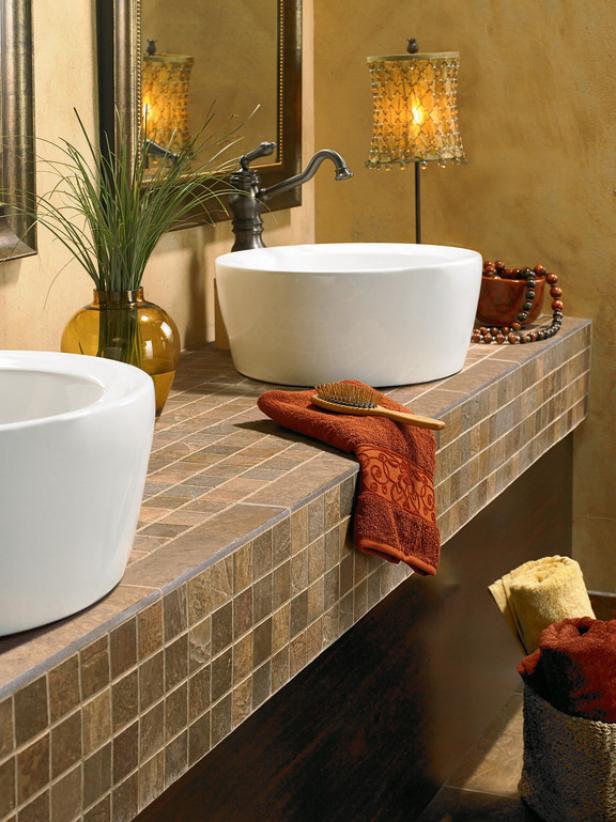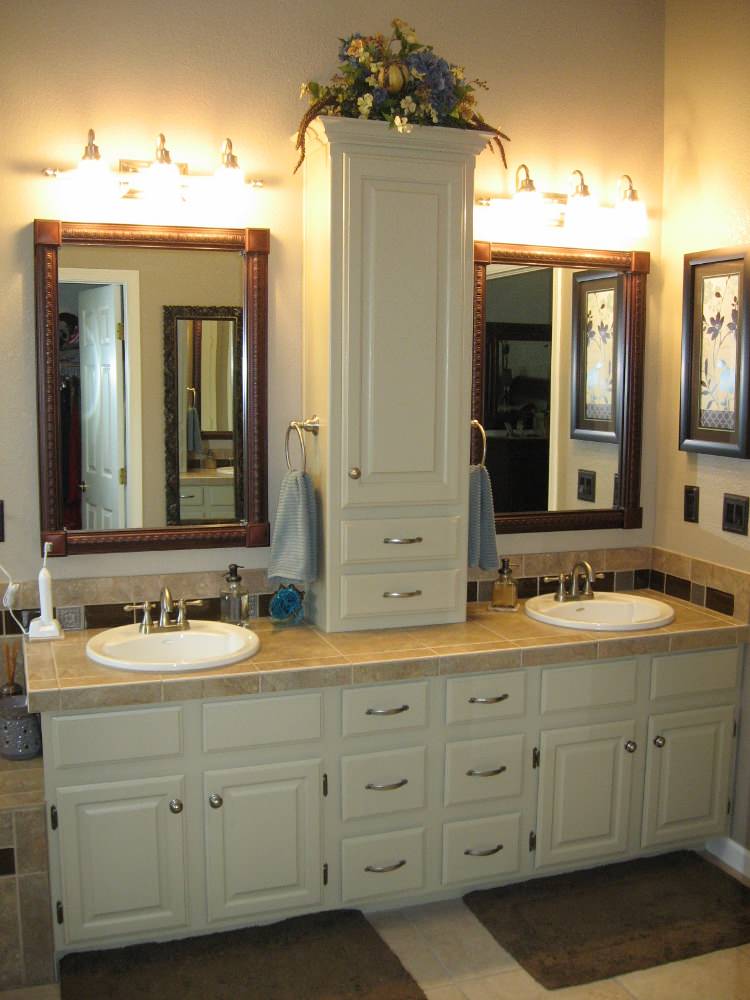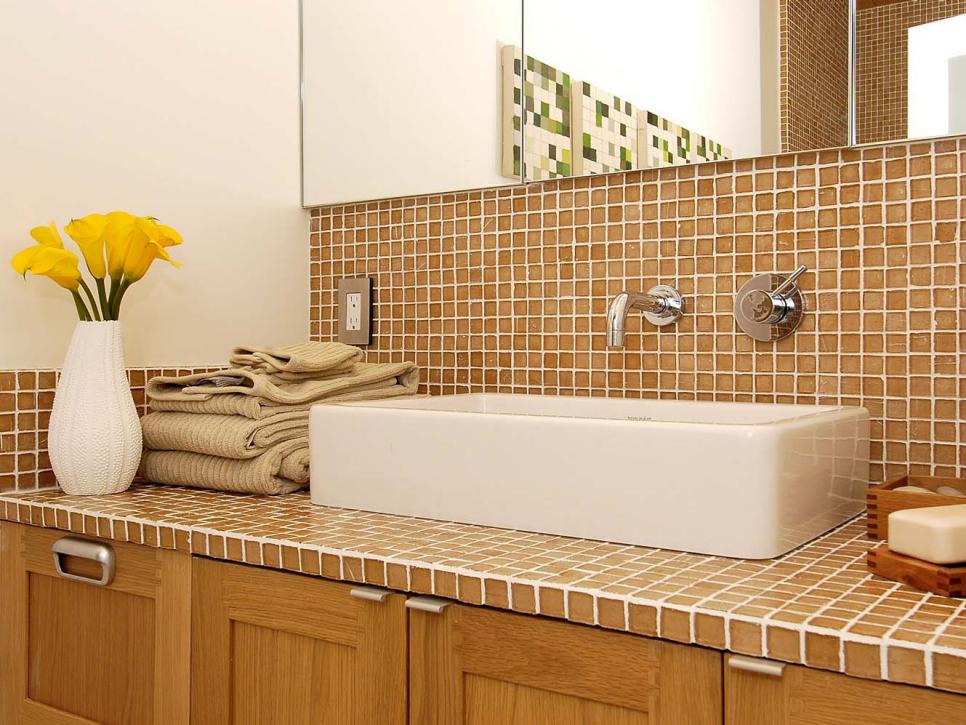When designing a bathroom, the countertop is a significant focal point that combines functionality with aesthetics. Tile countertops, in particular, offer a versatile and stylish option for bathroom spaces. They come in various materials, patterns, and colors, allowing homeowners to create a unique look that suits their taste and complements the overall design of the bathroom. Here are some comprehensive and informative ideas to inspire your bathroom countertop tile design.
Ceramic tiles are a popular choice for bathroom countertops due to their durability and affordability. They are available in an extensive range of colors, sizes, and finishes, making it easy to find a style that fits your bathroom decor. Ceramic tiles are water-resistant and easy to clean, which is essential in a bathroom environment. The glazed surface of ceramic tiles adds a layer of protection against stains and scratches, ensuring your countertop remains looking pristine with minimal maintenance.
Porcelain tiles are another excellent option for bathroom countertops. They are denser and more durable than ceramic tiles, making them highly resistant to moisture, stains, and scratches. Porcelain tiles are also available in a wide variety of colors and patterns, including options that mimic the look of natural stone or wood. Their low porosity makes them an ideal choice for wet environments, as they do not absorb water and are easy to clean. This makes porcelain tiles both a practical and stylish option for bathroom countertops.
Natural stone tiles, such as marble, granite, and travertine, bring a touch of luxury and elegance to bathroom countertops. Marble tiles are renowned for their classic beauty and unique veining patterns. However, they are more porous than other materials and require regular sealing to prevent stains and water damage. Granite tiles are incredibly durable and less porous than marble, making them a more practical choice for bathroom countertops. Travertine tiles offer a rustic, earthy look and are also less porous than marble, but still require sealing for protection. Each type of natural stone tile has its unique characteristics, offering a range of design possibilities.

Glass tiles provide a sleek and modern look for bathroom countertops. They are available in a variety of colors and finishes, including transparent, frosted, and iridescent options. Glass tiles are non-porous and highly resistant to stains and water, making them easy to clean and maintain. Their reflective surface can enhance the natural light in the bathroom, creating a bright and airy feel. Additionally, glass tiles can be used to create intricate mosaic patterns, adding a touch of artistry and personalization to the countertop.
For a unique and eco-friendly option, consider recycled tiles for your bathroom countertop. Recycled glass tiles are made from post-consumer and post-industrial glass, offering a sustainable and environmentally friendly choice. They come in a range of colors and styles, often with vibrant and eye-catching designs. Recycled ceramic tiles are another eco-friendly option, made from repurposed ceramic materials. Both recycled glass and ceramic tiles provide durability and easy maintenance, along with the satisfaction of choosing a green alternative for your bathroom design.
Mosaic tiles are an excellent choice for adding texture and visual interest to bathroom countertops. These small, often square tiles can be arranged in various patterns and designs, creating a custom look. Mosaic tiles are available in a range of materials, including ceramic, glass, stone, and metal, allowing for endless design possibilities. They are typically mounted on mesh sheets, making installation easier. Mosaic tiles can be used to create intricate patterns, borders, or accent areas on the countertop, adding a unique and personalized touch to the bathroom.

Subway tiles, traditionally used for walls and backsplashes, can also be an innovative choice for bathroom countertops. These rectangular tiles are typically ceramic or porcelain and are known for their clean, classic look. Subway tiles can be arranged in various patterns, such as herringbone or staggered brick, to create a distinctive design. Their durability and water resistance make them suitable for countertops, and their timeless appeal ensures they will look stylish for years to come. Pairing subway tiles with contrasting grout can further enhance the design and add a modern twist to this classic style.
Terracotta tiles offer a warm and rustic charm that can enhance the cozy feel of a bathroom. These clay-based tiles are available in natural, earthy tones, providing a grounded and organic look. Terracotta tiles are porous and require sealing to protect against moisture and stains, but their unique color variations and textures can add character and a Mediterranean-inspired touch to the bathroom. When properly maintained, terracotta tiles can provide a beautiful and long-lasting countertop surface.
For those seeking a bold and dramatic look, consider using large-format tiles on your bathroom countertop. These oversized tiles reduce the number of grout lines, creating a sleek and seamless appearance. Large-format tiles are available in various materials, including porcelain, ceramic, and natural stone, offering both durability and aesthetic appeal. The expansive surface area of large-format tiles can make a small bathroom appear larger and more open. Their modern and sophisticated look can transform the bathroom into a stylish retreat.
Metal tiles, such as stainless steel or copper, provide an industrial and contemporary look for bathroom countertops. Stainless steel tiles are highly durable, resistant to water and stains, and easy to clean. They offer a sleek and modern appearance, making them ideal for minimalist and industrial-inspired designs. Copper tiles, on the other hand, develop a natural patina over time, adding warmth and character to the bathroom. Both stainless steel and copper tiles can create a unique and eye-catching countertop that stands out in any bathroom design.

Patterned tiles can add a vibrant and eclectic touch to bathroom countertops. These tiles come in a wide range of designs, from geometric shapes to intricate floral patterns. Patterned tiles can be used to create a statement countertop that serves as the focal point of the bathroom. Mixing and matching different patterns can result in a playful and personalized look. Patterned tiles are available in various materials, including ceramic, porcelain, and cement, providing durability and easy maintenance along with their striking visual appeal.
Cement tiles, also known as encaustic tiles, offer a unique and artisanal look for bathroom countertops. These tiles are handmade using natural pigments and cement, resulting in rich, vibrant colors and intricate patterns. Cement tiles are highly durable and can withstand the wear and tear of daily use. They require sealing to protect against stains and moisture, but their distinctive designs and handcrafted quality make them a popular choice for adding character and charm to the bathroom.
Hexagonal tiles, often referred to as hex tiles, provide a geometric and modern look for bathroom countertops. These six-sided tiles are available in various materials, including ceramic, porcelain, and natural stone. Hex tiles can be arranged in different patterns, such as honeycomb or offset, to create a unique and eye-catching design. Their geometric shape adds visual interest and can complement both contemporary and traditional bathroom styles. Hexagonal tiles are durable and easy to clean, making them a practical and stylish option for countertops.
Wood-look tiles offer the warm and natural appearance of wood with the durability and water resistance of tile. These tiles are typically made from porcelain or ceramic and are designed to mimic the grain and texture of natural wood. Wood-look tiles are available in various shades and finishes, from light oak to dark walnut, providing a range of design possibilities. They are ideal for creating a cozy and inviting bathroom without the maintenance issues associated with real wood. Wood-look tiles combine the best of both worlds, offering a practical and beautiful countertop solution.
Stone-look tiles, such as those that mimic the appearance of marble, granite, or slate, offer the luxurious look of natural stone without the associated maintenance. These porcelain or ceramic tiles are designed to replicate the veining and texture of real stone, providing a high-end appearance. Stone-look tiles are highly durable, resistant to moisture and stains, and easy to clean. They offer a versatile and practical alternative to natural stone, allowing homeowners to achieve the desired look without the need for regular sealing and maintenance.

Common Mistakes to Avoid:
One common mistake when choosing bathroom countertop tiles is neglecting to consider the maintenance requirements of different materials. Some tiles, like natural stone and terracotta, require regular sealing to protect against moisture and stains. Failing to understand and commit to the necessary maintenance can lead to premature wear and damage. It’s essential to choose a tile material that fits your lifestyle and maintenance capabilities to ensure long-lasting beauty and functionality.
Another mistake is overlooking the importance of proper grout selection and maintenance. Grout lines can become stained and harbor mold if not properly sealed and maintained. Choosing a high-quality, stain-resistant grout and applying a sealer can help prevent these issues. Regular cleaning and resealing of grout lines are necessary to keep the countertop looking fresh and hygienic. Ignoring grout maintenance can diminish the overall appearance and cleanliness of the bathroom countertop.
Improper installation is a significant pitfall to avoid. Poorly installed tiles can result in uneven surfaces, weak adhesion, and water infiltration. It’s crucial to hire a professional installer with experience in tiling bathroom countertops to ensure a flawless result. Proper installation includes preparing the surface, using the right adhesive, and ensuring even spacing and alignment of tiles. Investing in professional installation can save you time and money in the long run by preventing costly repairs and reinstallation.

Choosing tiles based solely on aesthetics without considering their practical properties is another common error. While it’s important to select tiles that look good, they also need to be suitable for a bathroom environment. Tiles that are not water-resistant or durable enough for countertop use can quickly become damaged. Ensure that the tiles you choose are designed for bathroom use and can withstand moisture, heat, and daily wear and tear.
Neglecting to consider the countertop’s edge treatment can result in a less polished look. The edge treatment, whether it’s a simple bullnose, a more decorative ogee, or a custom edge, can significantly impact the overall appearance of the countertop. It’s important to select an edge treatment that complements the style of the tiles and the overall bathroom design. A well-finished edge can enhance the countertop’s aesthetics and provide a smooth, safe surface.
Failing to plan for tile layout and pattern alignment can lead to an unbalanced and chaotic look. It’s essential to plan the tile layout carefully, considering how the tiles will align with the edges, corners, and fixtures. Drying the tiles before installation can help you visualize the final result and make necessary adjustments. Proper planning ensures a cohesive and harmonious design, enhancing the overall appearance of the bathroom countertop.
Overlooking the impact of lighting on the appearance of tiles is another mistake. The way tiles look under different lighting conditions can vary significantly. It’s important to consider how natural and artificial light will affect the appearance of the tiles in your bathroom. Viewing tile samples in the actual bathroom space and under various lighting conditions can help you make a more informed decision and ensure the tiles look as expected.

What are the best tiles for bathroom countertops?
The best tiles for bathroom countertops depend on your specific needs and preferences. Ceramic and porcelain tiles are popular choices due to their durability, water resistance, and variety of styles. Natural stone tiles like marble, granite, and travertine offer a luxurious look but require regular sealing and maintenance. Glass tiles provide a sleek and modern appearance, while mosaic tiles can add texture and visual interest. Consider factors such as durability, maintenance, appearance, and budget when choosing the best tiles for your bathroom countertop.
How do I maintain and clean tile countertops in the bathroom?
The maintenance and cleaning of tile countertops in the bathroom vary depending on the material. Ceramic and porcelain tiles are easy to clean with mild soap and water. Natural stone tiles require regular sealing to prevent stains and water damage and should be cleaned with a pH-neutral cleaner. Glass tiles can be cleaned with a mild glass cleaner or soap and water. It’s important to also maintain the grout lines by sealing them and cleaning regularly to prevent staining and mold growth. Always follow the manufacturer’s recommendations for the specific tile material you have.
Can I install tile countertops myself, or should I hire a professional?
Installing tile countertops can be a complex task that requires precise measurements, proper tools, and expertise. While some DIY enthusiasts may be able to install tile countertops, it’s often best to hire a professional to ensure a flawless result. Professional installers have the experience and skills to properly prepare the surface, use the right adhesive, and ensure even spacing and alignment of tiles. Proper installation is crucial to prevent issues like uneven surfaces, weak adhesion, and water infiltration. Hiring a professional can save you time and ensure a high-quality finish.

How do I choose the right tile color and pattern for my bathroom countertop?
Choosing the right tile color and pattern involves considering the overall design and color scheme of your bathroom. Look for tiles that complement your cabinets, flooring, and fixtures. Neutral colors like white, beige, and gray are versatile and can fit into various design styles. Bold colors and patterns can create a striking focal point, but it’s important to ensure they don’t overwhelm the space. Viewing tile samples in your bathroom under different lighting conditions can help you visualize how the tiles will look. It’s also helpful to consider long-term trends and how the color and pattern will age over time.
What should I consider when setting a budget for bathroom tile countertops?
When setting a budget for bathroom tile countertops, consider the cost of the tiles, installation, and maintenance. Tile materials can vary widely in cost, with options like ceramic and porcelain being more budget-friendly, while natural stone and glass tiles can be more expensive. Installation costs can also vary depending on the complexity of the project and the tile material chosen. Factor in the cost of any necessary tools or additional materials if you’re considering a DIY installation. Maintenance costs, such as sealing for natural stone tiles or regular grout cleaning, should also be considered. Setting a realistic budget that includes all these factors will help you choose the best tiles for your needs without overspending.
Are there eco-friendly options for bathroom tile countertops?
Yes, there are several eco-friendly options for bathroom tile countertops. Recycled glass tiles are made from post-consumer and post-industrial glass, offering a sustainable and environmentally friendly choice. Recycled ceramic tiles are another eco-friendly option, made from repurposed ceramic materials. Both recycled glass and ceramic tiles provide durability and easy maintenance, along with the satisfaction of choosing a green alternative for your bathroom design. Additionally, tiles made from natural materials like terracotta and cement can be considered eco-friendly if sourced sustainably. Choosing eco-friendly tiles helps reduce your environmental impact and supports sustainable practices.

Related articles: